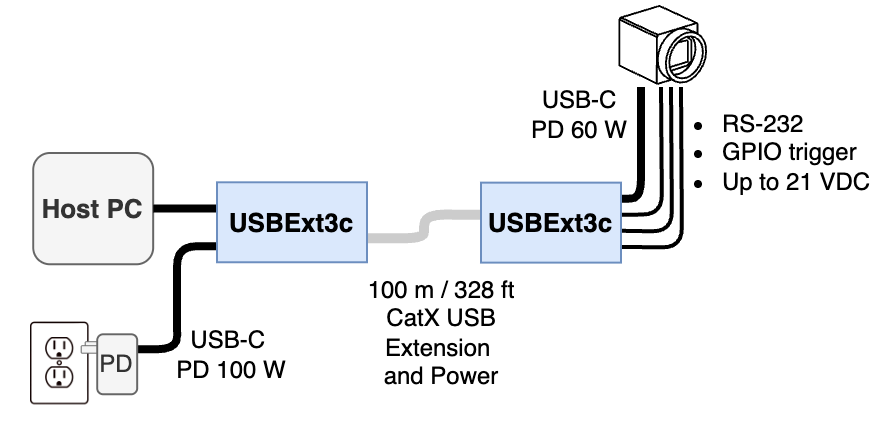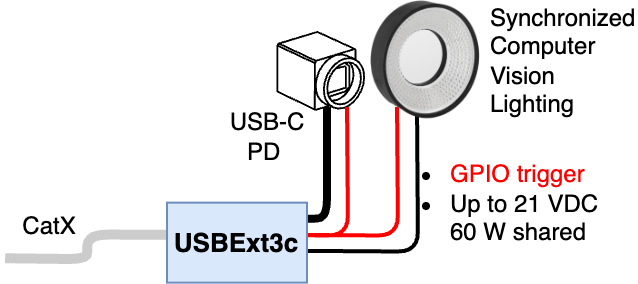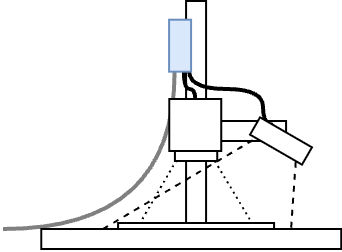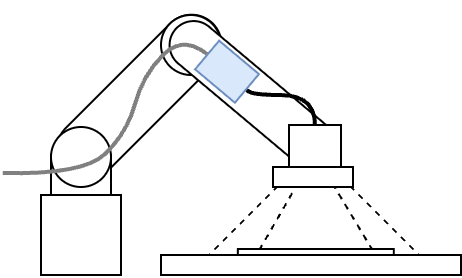USB3 Vision cameras are an ideal choice for many industrial computer vision applications due to their high performance, low cost, and extensive software support. However, cable length is limited to 3-5 m for passive USB cables. The Acroname USBExt3c extends that length to 100 m, delivering 5 Gbps USB and up to 60 W of remote power, RS-232, and GPIO all over a single Cat 6A cable. Extension is transparent to the camera and computer, working just like a local USB connection.
Summary
- Problem: USB 3 Vision is performant, easy to use, cost-effective, and broadly supported—but standard USB cable lengths severely restrict camera placement flexibility.
- Solution: USBExt3c extends USB3 Vision transparently to 100 meters over Cat 6A, delivering data, remote power, isolation, and I/O support.
- Benefit: Easier integration, lower cost of ownership, plug-and-play deployment, and robust support for applications like robotic vision, inspection, line scan, and packaging.
Camera Transport Tradeoffs
Industrial computer vision cameras use five primary transports:
| Interface | Max Throughput | Native Reach | Notes |
|---|---|---|---|
| 1 GigE Vision | 1 Gbps | 100 m Cat‑x | Similar cost to USB-3 Vision, but with lower resolutions or frame rates |
| USB3 Vision | 5 Gbps | 3-5 m | Plug‑and‑play, Power over Cable, best price/performance, 5x improvement over 1 GbE |
| 10 GigE Vision | 10 Gbps | 100 m Cat‑6A | Higher performance and cost, 10 GbE PHY gets hot, increasing camera noise |
| CoaXPress | 6–25 Gbps | 40 m coax / 300 m fiber | Highest performance and cost, Requires frame‑grabber, provides deterministic trigger |
| CameraLink HS | 9.6 Gbps / 16.8 Gbps | 300 m optical / 15 m copper | Highest performance and cost, Requires frame‑grabber, provides deterministic trigger |
1 GigE is a good choice for lower frame rates or resolutions at up to 100 m, while USB3 Vision offers the best price‑performance if you can overcome distance. USBExt3c gets you USB3 Vision's simplicity and performance while matching GigE’s reach.

USBExt3c Key features
Two identical compact hubs form the link.
- Two USB-C ports per extender unit - Add sensing, actuation, lighting, or another camera (depending on bandwidth required)
- 10 Gbps local link / 5 Gbps extended - Connect an additional device at the host end without impacting link bandwidth.
- Fully managed - Control and monitor port power and data, virtually plug and unplug connections.
- Any port, any role - Software-controllable port roles: flips a port between host (UFP) and device (DFP) on the fly.
- Flexible power - Power for either or both sides, with 60 W over-cable, and 90 W if powered locally, 2.8- 21 V programmable DC output.
- Flexible I/O - RS‑232 and GPIO trigger lines are extended for device control and synchronization
- Industrial build — M4 mounts, DIN‑rail bracket, locking USB‑C connectors.

Simplify bringup and debug
Engineers can tune CV applications on a laptop at their desk with the camera plugged into USB without needing a dedicated 10 GbE NIC or framegrabber. Debug factory-floor issues in-situ with a laptop.
Example Applications
In‑Cell Automated Optical Inspection
Mount the camera inside a work cell, run Cat 6A to a PC outside the safety perimeter for automated inspection of PCBs, small part alignment, and solder inspection.


Robot arm‑Mounted Vision
One Cat cable handles camera and accessory data and power making it easy to build into articulated arms. The second USB port, RS232 and GPIO connections enable simple integration of sensing, actuation, and lighting. Good for dedicated inspection tools or adding in-process inspection to existing tooling.
Workplace Safety monitoring
Cameras are usually statically mounted overhead, where USBExt3's ability to power the camera and accessories over the extension simplifies installation.
- Machinery safety: detect if workers have entered a safety perimeter
- Hazard detection
- Safety compliance: catch issues before an injury happens
Packaging Lines
- Automated picking
- Packing verification
- Cap‑alignment checks, fill‑level detection
- Text label / barcode / QR code scanning and verification
Clean rooms and Hoods
Extend high‑resolution inspection cameras into laminar‑flow hoods or clean environments. Keep compute and storage outside controlled zones
Line scan inspection
USB3 Vision line scan cameras are a good choice for inspection of continuous materials like textiles and films, or on high-speed production lines. USB3 Vision supports many 2k-4k line scan applications at 40-60 kHz without expensive frame grabbers. Paired with USBExt3c, these cameras can be positioned where needed on the line, up to 100 m from the host PC.
Implementation Tips
- Cable - Cat 6A S/FTP recommended; avoid pass‑through panels for 100 m runs.
- Power - 60 W is far more power than any camera will need, but be mindful of maximum power draw of accessories to avoid brownout.
- GPIO / RS‑232 - Use shielded cable to avoid crosstalk.
- Schedule camera resets - Use USBExt3c's software control to script virtual plug and unplug of cameras if freezes occur.
Conclusion
USBExt3c lets you extend existing USB3Vision installations, simplify bringup and testing, while matching GigE distances, with flexible power and port-level control.
FAQ
Is USB3 Vision the same as UVC? No: USB3 Vision uses GenICam over USB; UVC is a generic video class. Some cameras support both. USBExt3c can reliably extend either transport.
How many cameras per extender? One USB3 Vision camera at maximum data rate, or two at reduced frame rate or resolution.
Can I mix 10 Gbps local devices and 5 Gbps extension? Yes—local ports run at 10 Gbps while the Cat 6A link is at 5 Gbps.
Add New Comment